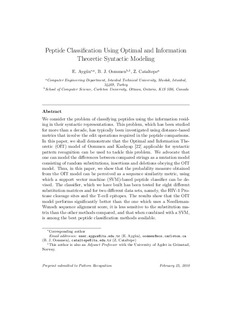| dc.contributor.author | Aygün, Ezra | |
| dc.contributor.author | Oommen, B. John | |
| dc.contributor.author | Cataltepe, Z | |
| dc.date.accessioned | 2011-01-18T13:36:17Z | |
| dc.date.available | 2011-01-18T13:36:17Z | |
| dc.date.issued | 2010 | |
| dc.identifier.citation | Aygün, E., Oommen, B. J., & Cataltepe, Z. (2010). Peptide classification using optimal and information theoretic syntactic modeling. Pattern Recognition, 43(11), 3891-3899. doi: 10.1016/j.patcog.2010.05.022 | en_US |
| dc.identifier.issn | 0031-3203 | |
| dc.identifier.uri | http://hdl.handle.net/11250/137852 | |
| dc.description | Accepted version of an article published in the journal: Pattern Recognition. Published version available on Sciverse: http://dx.doi.org/10.1016/j.patcog.2010.05.022 | en_US |
| dc.description.abstract | We consider the problem of classifying peptides using the information residing in their syntactic representations. This problem, which has been studied for more than a decade, has typically been investigated using distance-based metrics that involve the edit operations required in the peptide comparisons. In this paper, we shall demonstrate that the Optimal and Information Theoretic (OIT) model of Oommen and Kashyap [22] applicable for syntactic pattern recognition can be used to tackle peptide classification problem. We advocate that one can model the differences between compared strings as a mutation model consisting of random substitutions, insertions and deletions obeying the OIT model. Thus, in this paper, we show that the probability measure obtained from the OIT model can be perceived as a sequence similarity metric, using which a support vector machine (SVM)-based peptide classifier can be devised. The classifier, which we have built has been tested for eight different substitution matrices and for two different data sets, namely, the HIV-1 Protease cleavage sites and the T-cell epitopes. The results show that the OIT model performs significantly better than the one which uses a Needleman-Wunsch sequence alignment score, it is less sensitive to the substitution matrix than the other methods compared, and that when combined with a SVM, is among the best peptide classification methods available | en_US |
| dc.language.iso | eng | en_US |
| dc.publisher | Elsevier | en_US |
| dc.title | Peptide classification using optimal and information theoretic syntactic modeling | en_US |
| dc.type | Journal article | en_US |
| dc.type | Peer reviewed | en_US |
| dc.subject.nsi | VDP::Mathematics and natural science: 400::Information and communication science: 420::Algorithms and computability theory: 422 | en_US |
| dc.subject.nsi | VDP::Medical disciplines: 700::Basic medical, dental and veterinary science disciplines: 710::Medical molecular biology: 711 | en_US |
| dc.source.pagenumber | 3891-3899 | en_US |
